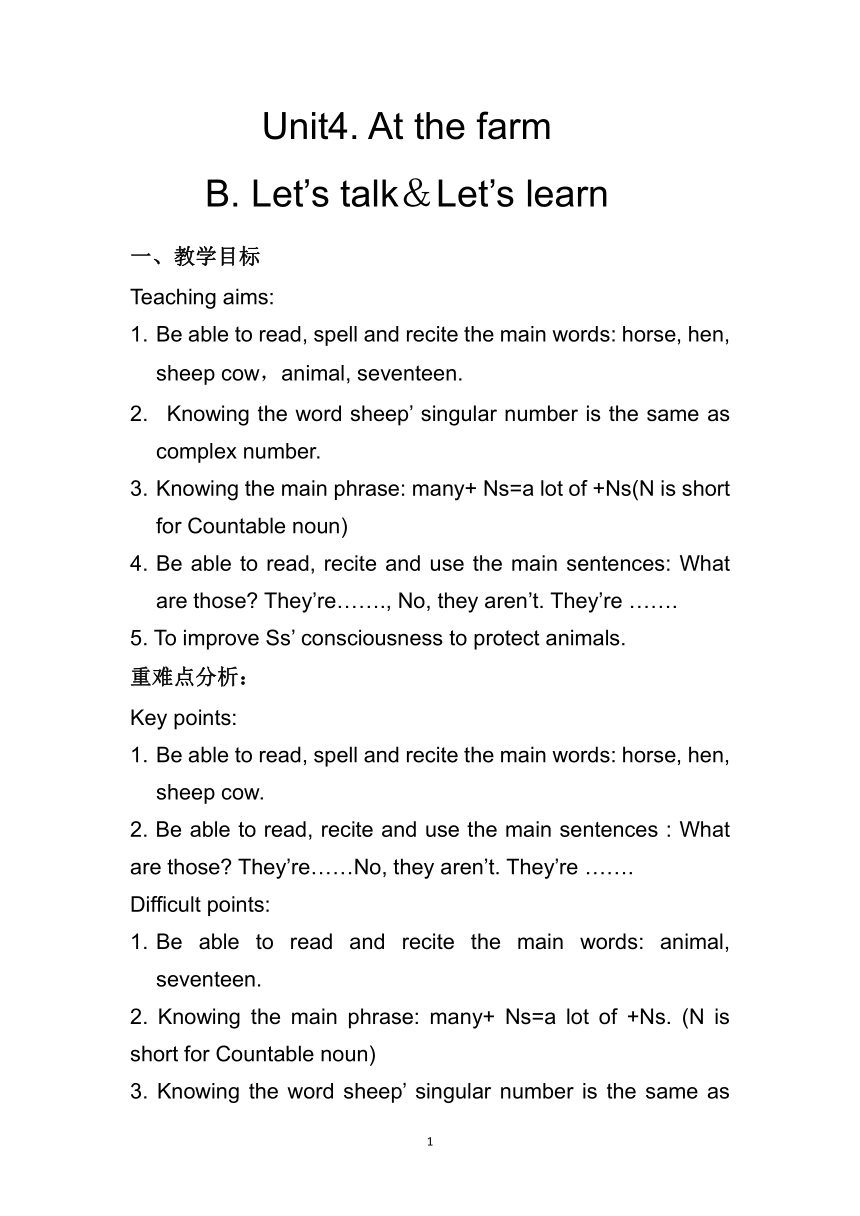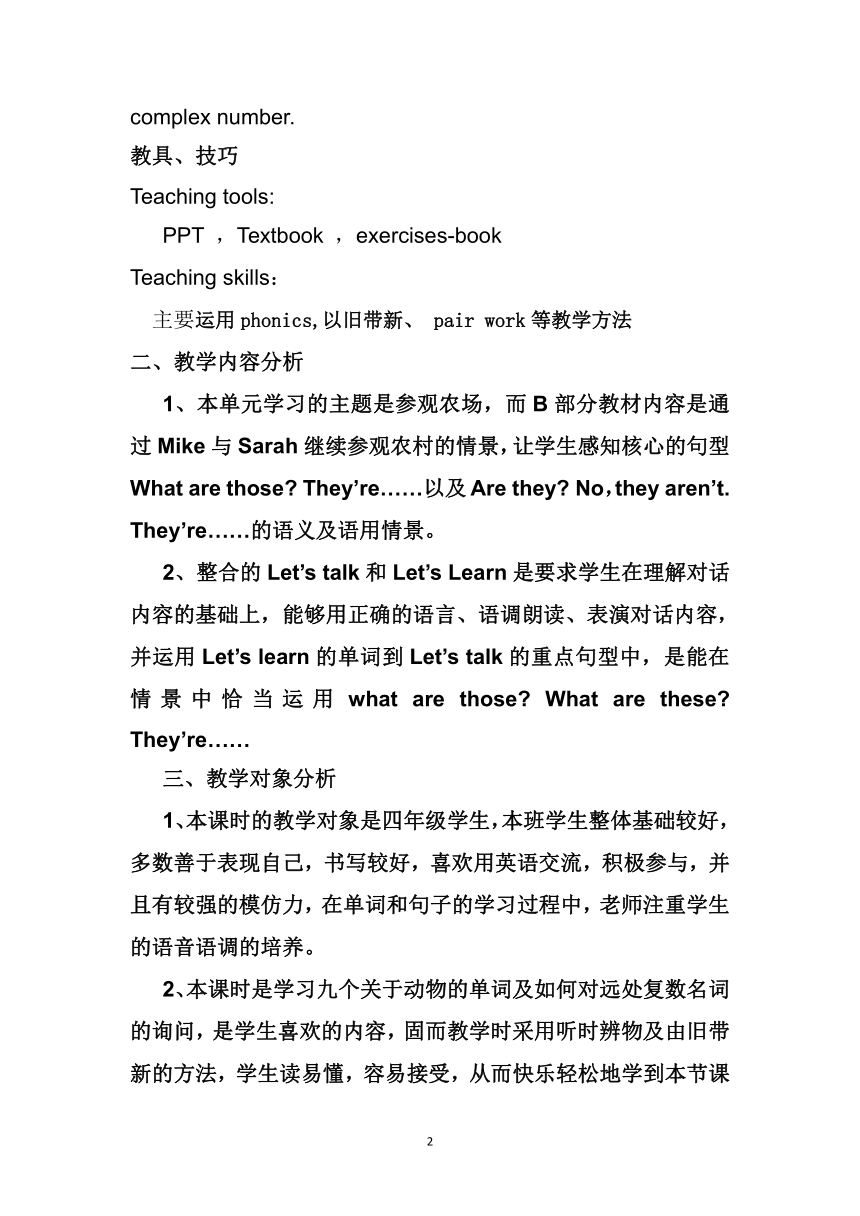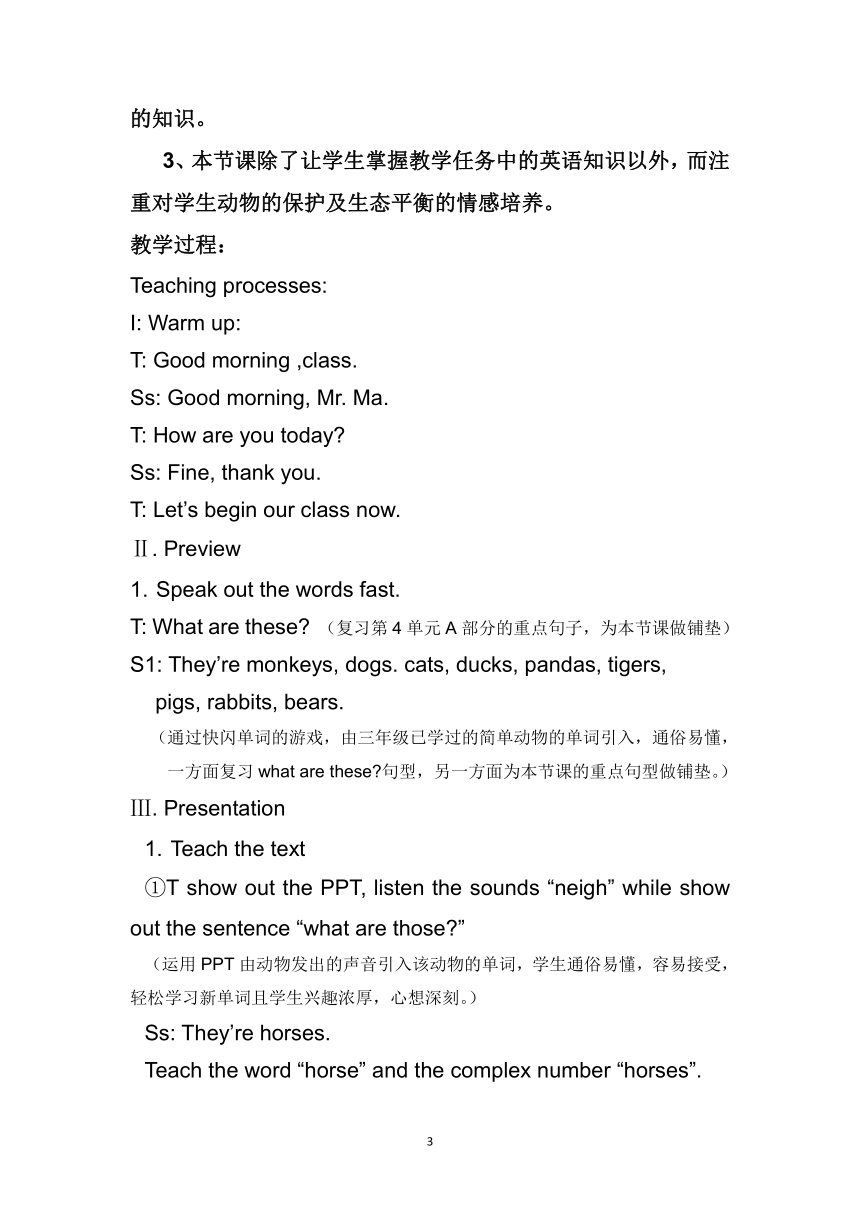Unit4 At the farm Prt B Let’stalk&Let’slearn 教案(共2课时)
文档属性
| 名称 | Unit4 At the farm Prt B Let’stalk&Let’slearn 教案(共2课时) |  | |
| 格式 | docx | ||
| 文件大小 | 23.1KB | ||
| 资源类型 | 教案 | ||
| 版本资源 | 人教版(PEP) | ||
| 科目 | 英语 | ||
| 更新时间 | 2022-02-19 15:33:38 | ||
图片预览



文档简介
Unit4. At the farm
B. Let’s talk&Let’s learn
一、教学目标
Teaching aims:
Be able to read, spell and recite the main words: horse, hen, sheep cow,animal, seventeen.
Knowing the word sheep’ singular number is the same as complex number.
Knowing the main phrase: many+ Ns=a lot of +Ns(N is short for Countable noun)
Be able to read, recite and use the main sentences: What are those They’re……., No, they aren’t. They’re …….
5. To improve Ss’ consciousness to protect animals.
重难点分析:
Key points:
Be able to read, spell and recite the main words: horse, hen, sheep cow.
2. Be able to read, recite and use the main sentences : What are those They’re……No, they aren’t. They’re …….
Difficult points:
Be able to read and recite the main words: animal, seventeen.
2. Knowing the main phrase: many+ Ns=a lot of +Ns. (N is short for Countable noun)
3. Knowing the word sheep’ singular number is the same as complex number.
教具、技巧
Teaching tools:
PPT ,Textbook ,exercises-book
Teaching skills:
主要运用phonics,以旧带新、 pair work等教学方法
二、教学内容分析
1、本单元学习的主题是参观农场,而B部分教材内容是通过Mike与Sarah继续参观农村的情景,让学生感知核心的句型
What are those They’re……以及Are they No,they aren’t. They’re……的语义及语用情景。
2、整合的Let’s talk和Let’s Learn是要求学生在理解对话内容的基础上,能够用正确的语言、语调朗读、表演对话内容,并运用Let’s learn的单词到Let’s talk的重点句型中,是能在情景中恰当运用what are those What are these They’re……
三、教学对象分析
1、本课时的教学对象是四年级学生,本班学生整体基础较好,多数善于表现自己,书写较好,喜欢用英语交流,积极参与,并且有较强的模仿力,在单词和句子的学习过程中,老师注重学生的语音语调的培养。
2、本课时是学习九个关于动物的单词及如何对远处复数名词的询问,是学生喜欢的内容,固而教学时采用听时辨物及由旧带新的方法,学生读易懂,容易接受,从而快乐轻松地学到本节课的知识。
3、本节课除了让学生掌握教学任务中的英语知识以外,而注重对学生动物的保护及生态平衡的情感培养。
教学过程:
Teaching processes:
I: Warm up:
T: Good morning ,class.
Ss: Good morning, Mr. Ma.
T: How are you today
Ss: Fine, thank you.
T: Let’s begin our class now.
Ⅱ. Preview
Speak out the words fast.
T: What are these (复习第4单元A部分的重点句子,为本节课做铺垫)
S1: They’re monkeys, dogs. cats, ducks, pandas, tigers,
pigs, rabbits, bears.
(通过快闪单词的游戏,由三年级已学过的简单动物的单词引入,通俗易懂,一方面复习what are these 句型,另一方面为本节课的重点句型做铺垫。)
Ⅲ. Presentation
Teach the text
①T show out the PPT, listen the sounds “neigh” while show out the sentence “what are those ”
(运用PPT由动物发出的声音引入该动物的单词,学生通俗易懂,容易接受,轻松学习新单词且学生兴趣浓厚,心想深刻。)
Ss: They’re horses.
Teach the word “horse” and the complex number “horses”.
(运用PPT先出现horses,再出现单数horse,教授新单词,最后又出现horses,强调复数。)
T: How many horses do you have
S1:Ten.
(ten这个单词是为了衔接学习下一个新单词而特意设计的)
②Though the word“ ten—pen—pencil ”to teach the new word “hen”.
(运用PPT通过简单单词中含有相同发音的字母组合en顺其自然引入新单词hen通俗易懂,学生容易接受。)
③ Listen the sound “cluck” to show the picture “hens” and the sentence “They are hens.”
(运用PPT由动物的声音引入该动物的单词,学生通俗易懂,容易接受,轻松学习新单词且学生感兴趣。)
④T show out the picture drawing “ducks” and ask “Are they hens ”, and the Ss answer NO, they aren’t. They’re ducks. Wow! They’re so cute!!!”
(单数hen到“母鸡hens”单词自然而然过渡到出现卡通动态的唐老鸭,自然而生动,学生印象深刻,容易掌握,同时掌握重点句型,且出现语气助词wow为新授单词cow做铺垫。)
⑤Using the word “wow—how— now” to teach the new word cow with the picture.
(运用PPT通过简单单词中含有相同发音的字母组合ow顺其自然引入新单词cow通俗易懂,学生容易接受。)
⑥Listen the sound “moo” while T show out the sentence and ask “What are those ”。
(运用PPT由动物的声音引入该动物的单词,学生通俗易懂,容易接受,轻松学习新单词且学生兴趣浓厚。)
Ss: They’re cows.
T: How many cows can you see
S: One, two, three, four…… Many cows.
(选用画有许多牛图画引入many +可数名词的复数形式。)
T: Many cows mean a lot of cows.
(让学生理解a lot of是许多的意义及简单的该短语后可加可数名词的复数形式的用法)
⑦Show the picture copy a cow and a bee, then show out the word “bee—beef” to teach the new word “sheep”.
(运用上新单词cow带入蜜蜂bee, 运用PPT通过简单单词中含有相同发音的字母组合ee顺其自然引入新单词sheep通俗易懂,学生容易接受。)
⑧Listen the sound while show out the sentence and answer “What are those ”
(运用PPT由动物的声音引入该动物的单词,学生通俗易懂,容易接受,轻松学生新单词且学生感兴趣。)
S: They are sheeps, teach the word “sheep” the singular number is the same as complex number.
(图中首先出现单词sheeps复数形式的错误写法,通过引导强调的后再把字母“s”去掉,目的让学生印象深刻,加强记忆。)
⑨Show out the picture drawing “horses, sheep and a cow”.
(引入难点单词seventeen.)
To ask: How many horses do you have
Ss: Seventeen.
T teach the word “seventeen”
⑩Show out the picture drawing many animals do the pair work, S1: What are those S2: They’re…….”
(将课堂还给学生,新授内容后让学生自由反复操练,以巩固本节课重难点句型及单词。)
T: many animals mean a lot of animals.
“We have a lot of animals!
⑾ Show out the grammar “How to change the singular number to complex number.
(简单讲解相关语法。)
Learn and act out the text.
Ⅳ.Consolidation&Extension
DO the exercises.
Ⅴ.Summary
See the video.
Q:What will you learn from the video
Answers: We all love a lot of animals.
Animals also are our friends.
Don’t Wear a Cow Man!
Ⅵ.Homework
Blackboard design:
Unit4 At the farm
B. Let’s talk&Let’s learn
What are those
horses hens
They’re
sheep cows
We all love a lot of animals!
教学反思:
亮点:
这是一节Let’s talk和 Let’s learn的整合课,我先通过以旧带新的教学方法,运用phonics教学,学生很容易认识与记忆新单词,从而提高学生记单词的能力。另外,通过动物的叫声,慢慢渗透新句型,这样更容易激起学生们的兴趣与好奇心。然后通过pair work的练习,让学生更加熟悉课文对话,让学生易学,乐学。
不足之处:
本节课学生操练还可以加大,如果能兼顾书写方面的操练效果会更好。
1
B. Let’s talk&Let’s learn
一、教学目标
Teaching aims:
Be able to read, spell and recite the main words: horse, hen, sheep cow,animal, seventeen.
Knowing the word sheep’ singular number is the same as complex number.
Knowing the main phrase: many+ Ns=a lot of +Ns(N is short for Countable noun)
Be able to read, recite and use the main sentences: What are those They’re……., No, they aren’t. They’re …….
5. To improve Ss’ consciousness to protect animals.
重难点分析:
Key points:
Be able to read, spell and recite the main words: horse, hen, sheep cow.
2. Be able to read, recite and use the main sentences : What are those They’re……No, they aren’t. They’re …….
Difficult points:
Be able to read and recite the main words: animal, seventeen.
2. Knowing the main phrase: many+ Ns=a lot of +Ns. (N is short for Countable noun)
3. Knowing the word sheep’ singular number is the same as complex number.
教具、技巧
Teaching tools:
PPT ,Textbook ,exercises-book
Teaching skills:
主要运用phonics,以旧带新、 pair work等教学方法
二、教学内容分析
1、本单元学习的主题是参观农场,而B部分教材内容是通过Mike与Sarah继续参观农村的情景,让学生感知核心的句型
What are those They’re……以及Are they No,they aren’t. They’re……的语义及语用情景。
2、整合的Let’s talk和Let’s Learn是要求学生在理解对话内容的基础上,能够用正确的语言、语调朗读、表演对话内容,并运用Let’s learn的单词到Let’s talk的重点句型中,是能在情景中恰当运用what are those What are these They’re……
三、教学对象分析
1、本课时的教学对象是四年级学生,本班学生整体基础较好,多数善于表现自己,书写较好,喜欢用英语交流,积极参与,并且有较强的模仿力,在单词和句子的学习过程中,老师注重学生的语音语调的培养。
2、本课时是学习九个关于动物的单词及如何对远处复数名词的询问,是学生喜欢的内容,固而教学时采用听时辨物及由旧带新的方法,学生读易懂,容易接受,从而快乐轻松地学到本节课的知识。
3、本节课除了让学生掌握教学任务中的英语知识以外,而注重对学生动物的保护及生态平衡的情感培养。
教学过程:
Teaching processes:
I: Warm up:
T: Good morning ,class.
Ss: Good morning, Mr. Ma.
T: How are you today
Ss: Fine, thank you.
T: Let’s begin our class now.
Ⅱ. Preview
Speak out the words fast.
T: What are these (复习第4单元A部分的重点句子,为本节课做铺垫)
S1: They’re monkeys, dogs. cats, ducks, pandas, tigers,
pigs, rabbits, bears.
(通过快闪单词的游戏,由三年级已学过的简单动物的单词引入,通俗易懂,一方面复习what are these 句型,另一方面为本节课的重点句型做铺垫。)
Ⅲ. Presentation
Teach the text
①T show out the PPT, listen the sounds “neigh” while show out the sentence “what are those ”
(运用PPT由动物发出的声音引入该动物的单词,学生通俗易懂,容易接受,轻松学习新单词且学生兴趣浓厚,心想深刻。)
Ss: They’re horses.
Teach the word “horse” and the complex number “horses”.
(运用PPT先出现horses,再出现单数horse,教授新单词,最后又出现horses,强调复数。)
T: How many horses do you have
S1:Ten.
(ten这个单词是为了衔接学习下一个新单词而特意设计的)
②Though the word“ ten—pen—pencil ”to teach the new word “hen”.
(运用PPT通过简单单词中含有相同发音的字母组合en顺其自然引入新单词hen通俗易懂,学生容易接受。)
③ Listen the sound “cluck” to show the picture “hens” and the sentence “They are hens.”
(运用PPT由动物的声音引入该动物的单词,学生通俗易懂,容易接受,轻松学习新单词且学生感兴趣。)
④T show out the picture drawing “ducks” and ask “Are they hens ”, and the Ss answer NO, they aren’t. They’re ducks. Wow! They’re so cute!!!”
(单数hen到“母鸡hens”单词自然而然过渡到出现卡通动态的唐老鸭,自然而生动,学生印象深刻,容易掌握,同时掌握重点句型,且出现语气助词wow为新授单词cow做铺垫。)
⑤Using the word “wow—how— now” to teach the new word cow with the picture.
(运用PPT通过简单单词中含有相同发音的字母组合ow顺其自然引入新单词cow通俗易懂,学生容易接受。)
⑥Listen the sound “moo” while T show out the sentence and ask “What are those ”。
(运用PPT由动物的声音引入该动物的单词,学生通俗易懂,容易接受,轻松学习新单词且学生兴趣浓厚。)
Ss: They’re cows.
T: How many cows can you see
S: One, two, three, four…… Many cows.
(选用画有许多牛图画引入many +可数名词的复数形式。)
T: Many cows mean a lot of cows.
(让学生理解a lot of是许多的意义及简单的该短语后可加可数名词的复数形式的用法)
⑦Show the picture copy a cow and a bee, then show out the word “bee—beef” to teach the new word “sheep”.
(运用上新单词cow带入蜜蜂bee, 运用PPT通过简单单词中含有相同发音的字母组合ee顺其自然引入新单词sheep通俗易懂,学生容易接受。)
⑧Listen the sound while show out the sentence and answer “What are those ”
(运用PPT由动物的声音引入该动物的单词,学生通俗易懂,容易接受,轻松学生新单词且学生感兴趣。)
S: They are sheeps, teach the word “sheep” the singular number is the same as complex number.
(图中首先出现单词sheeps复数形式的错误写法,通过引导强调的后再把字母“s”去掉,目的让学生印象深刻,加强记忆。)
⑨Show out the picture drawing “horses, sheep and a cow”.
(引入难点单词seventeen.)
To ask: How many horses do you have
Ss: Seventeen.
T teach the word “seventeen”
⑩Show out the picture drawing many animals do the pair work, S1: What are those S2: They’re…….”
(将课堂还给学生,新授内容后让学生自由反复操练,以巩固本节课重难点句型及单词。)
T: many animals mean a lot of animals.
“We have a lot of animals!
⑾ Show out the grammar “How to change the singular number to complex number.
(简单讲解相关语法。)
Learn and act out the text.
Ⅳ.Consolidation&Extension
DO the exercises.
Ⅴ.Summary
See the video.
Q:What will you learn from the video
Answers: We all love a lot of animals.
Animals also are our friends.
Don’t Wear a Cow Man!
Ⅵ.Homework
Blackboard design:
Unit4 At the farm
B. Let’s talk&Let’s learn
What are those
horses hens
They’re
sheep cows
We all love a lot of animals!
教学反思:
亮点:
这是一节Let’s talk和 Let’s learn的整合课,我先通过以旧带新的教学方法,运用phonics教学,学生很容易认识与记忆新单词,从而提高学生记单词的能力。另外,通过动物的叫声,慢慢渗透新句型,这样更容易激起学生们的兴趣与好奇心。然后通过pair work的练习,让学生更加熟悉课文对话,让学生易学,乐学。
不足之处:
本节课学生操练还可以加大,如果能兼顾书写方面的操练效果会更好。
1
